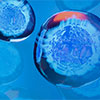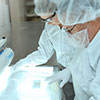chromatography+columns+HyClone+products+(Cytiva)
Catalog Number:
(10111-052)
Supplier:
Prosci
Description:
The protein encoded by CDK8 is a member of the cyclin-dependent protein kinase (CDK) family. CDK family members are highly similar to the gene products of Saccharomyces cerevisiae cdc28, and Schizosaccharomyces pombe cdc2, and are known to be important regulators of cell cycle progression. This kinase and its regulatory subunit cyclin C are components of the RNA polymerase II holoenzyme complex, which phosphorylates the carboxy-terminal domain (CTD) of the largest subunit of RNA polymerase II. This kinase has also been shown to regulate transcription by targeting the CDK7/cyclin H subunits of the general transcription initiation factor IIH (TFIIH), thus providing a link between the 'Mediator-like' protein complexes and the basal transcription machinery.
Catalog Number:
(CA613-4630)
Supplier:
Rockland Immunochemical
Description:
This product has been assayed against 1.0 µg of Sheep IgG in a standard capture ELISA using Peroxidase Conjugated Streptavidin and ABTS (2,2’-azino-bis-[3-ethylbenthiazoline-6-sulfonic acid])
Supplier:
LIFE TECHNOLOGIES CORP CA
Description:
The Pierce™ NAb™ Spin Kits are convenient for rapid, small-scale affinity purification of antibodies from a variety of sample types. Each pre-filled microcentrifuge spin column of the immobilized protein resin enables quick purification of 100 to 1000 µg of IgG from 25 to 500 µL of serum or other sample. The actual amount of IgG purified varies depending upon the sample type and the specific spin column used.
Catalog Number:
(CA605-4303)
Supplier:
Rockland Immunochemical
Description:
Goat IgG F(c) peroxidase conjugated antibody has been assayed against 1.0 µg of Goat IgG in a standard capture ELISA using TMB as a substrate for 30 minutes at room temperature. A working dilution of 1:4,000 to 1:16,000 is suggested for this product.
Catalog Number:
(97055-082)
Supplier:
Upchurch Scientific
Description:
Fused silica tubing is offered in the most common 360 μm Ext.Ø and in convenient 2 m lengths.
Catalog Number:
(CA003-0202)
Supplier:
Rockland Immunochemical
Description:
Produced through a multi-stage process that includes delipidation, salt fractionation, ion-exchange chromatography, gel filtration, and affinity chromatography. No contaminating proteins are observed when assayed at a protein concentration of 20mg/mL against anti-whole serum or anti-fragment specific antisera. All immunoglobulin fragments are prepared from highly purified, whole molecules subject to enzymatic digestion.
Catalog Number:
(CA004-0202)
Supplier:
Rockland Immunochemical
Description:
Produced through a multi-stage process that includes delipidation, salt fractionation, ion-exchange chromatography, gel filtration, and affinity chromatography. No contaminating proteins are observed when assayed at a protein concentration of 20mg/mL against anti-whole serum or anti-fragment specific antisera. All immunoglobulin fragments are prepared from highly purified, whole molecules subject to enzymatic digestion.
Catalog Number:
(CA005-0202)
Supplier:
Rockland Immunochemical
Description:
Produced through a multi-stage process that includes delipidation, salt fractionation, ion-exchange chromatography, gel filtration, and affinity chromatography. No contaminating proteins are observed when assayed at a protein concentration of 20mg/mL against anti-whole serum or anti-fragment specific antisera. All immunoglobulin fragments are prepared from highly purified, whole molecules subject to enzymatic digestion.
Catalog Number:
(10111-018)
Supplier:
Prosci
Description:
YWHAQ belongs to the 14-3-3 family of proteins which mediate signal transduction by binding to phosphoserine-containing proteins. This highly conserved protein family is found in both plants and mammals, and this protein is 99% identical to the mouse and rat orthologs. This gene is upregulated in patients with amyotrophic lateral sclerosis.This gene product belongs to the 14-3-3 family of proteins which mediate signal transduction by binding to phosphoserine-containing proteins. This highly conserved protein family is found in both plants and mammals, and this protein is 99% identical to the mouse and rat orthologs. This gene is upregulated in patients with amyotrophic lateral sclerosis. It contains in its 5' UTR a 6 bp tandem repeat sequence which is polymorphic, however, there is no correlation between the repeat number and the disease.
Catalog Number:
(10106-884)
Supplier:
Prosci
Description:
MTA1 encodes a protein that was identified in a screen for genes expressed in metastatic cells, specifically, mammary adenocarcinoma cell lines. Expression of this gene has been correlated with the metastatic potential of at least two types of carcinomas although it is also expressed in many normal tissues. The role it plays in metastasis is unclear. MTA1 was initially thought to be the 70kD component of a nucleosome remodeling deacetylase complex, NuRD, but it is more likely that this component is a different but very similar protein. These two proteins are so closely related, though, that they share the same types of domains. These domains include two DNA binding domains, a dimerization domain, and a domain commonly found in proteins that methylate DNA. The profile and activity of this gene product suggest that it is involved in regulating transcription and that this may be accomplished by chromatin remodeling.
Catalog Number:
(10106-760)
Supplier:
Prosci
Description:
FXYD5 is a member of a family of small membrane proteins that share a 35-amino acid signature sequence domain, beginning with the sequence PFXYD and containing 7 invariant and 6 highly conserved amino acids. The approved human gene nomenclature for the family is FXYD-domain containing ion transport regulator. Mouse FXYD5 has been termed RIon Channel (Related to Ion Channel). FXYD2, also known as the gamma subunit of the Na,K-ATPase, regulates the properties of that enzyme. FXYD1 (phospholemman), FXYD2 (gamma), FXYD3 (MAT-8), FXYD4 (CHIF), and FXYD5 (RIon Channel) have been shown to induce channel activity in experimental expression systems. Transmembrane topology has been established for two family members (FXYD1 and FXYD2), with the N-terminus extracellular and the C-terminus on the cytoplasmic side of the membrane. This gene product, FXYD5, has not been characterized as a protein.
Catalog Number:
(10102-332)
Supplier:
Prosci
Description:
CDC5L shares a significant similarity with Schizosaccharomyces pombe cdc5 gene product, which is a cell cycle regulator important for G2/M transition. CDC5L has been demonstrated to act as a positive regulator of cell cycle G2/M progression. It was also found to be an essential component of a non-snRNA spliceosome, which contains at least five additional protein factors and is required for the second catalytic step of pre-mRNA splicing.The protein encoded by this gene shares a significant similarity with Schizosaccharomyces pombe cdc5 gene product, which is a cell cycle regulator important for G2/M transition. This protein has been demonstrated to act as a positive regulator of cell cycle G2/M progression. It was also found to be an essential component of a non-snRNA spliceosome, which contains at least five additional protein factors and is required for the second catalytic step of pre-mRNA splicing. Publication Note: This RefSeq record includes a subset of the publications that are available for this gene. Please see the Entrez Gene record to access additional publications.
Catalog Number:
(10108-620)
Supplier:
Prosci
Description:
FGA is the alpha component of fibrinogen, a blood-borne glycoprotein comprised of three pairs of nonidentical polypeptide chains. Following vascular injury, fibrinogen is cleaved by thrombin to form fibrin which is the most abundant component of blood clots. In addition, various cleavage products of fibrinogen and fibrin regulate cell adhesion and spreading, display vasoconstrictor and chemotactic activities, and are mitogens for several cell types. Mutations in its gene lead to several disorders, including dysfibrinogenemia, hypofibrinogenemia, afibrinogenemia and renal amyloidosis.The protein encoded by this gene is the alpha component of fibrinogen, a blood-borne glycoprotein comprised of three pairs of nonidentical polypeptide chains. Following vascular injury, fibrinogen is cleaved by thrombin to form fibrin which is the most abundant component of blood clots. In addition, various cleavage products of fibrinogen and fibrin regulate cell adhesion and spreading, display vasoconstrictor and chemotactic activities, and are mitogens for several cell types. Mutations in this gene lead to several disorders, including dysfibrinogenemia, hypofibrinogenemia, afibrinogenemia and renal amyloidosis. Alternative splicing results in two isoforms which vary in the carboxy-terminus.
Catalog Number:
(10110-512)
Supplier:
Prosci
Description:
AIFM1 (PDCD8) is a flavoprotein essential for nuclear disassembly in apoptotic cells that is found in the mitochondrial intermembrane space in healthy cells. Induction of apoptosis results in the translocation of this protein to the nucleus where it effects chromosome condensation and fragmentation. In addition, AIFM1 induces mitochondria to release the apoptogenic proteins cytochrome c and caspase-9.This gene encodes a flavoprotein essential for nuclear disassembly in apoptotic cells that is found in the mitochondrial intermembrane space in healthy cells. Induction of apoptosis results in the translocation of this protein to the nucleus where it effects chromosome condensation and fragmentation. In addition, this gene product induces mitochondria to release the apoptogenic proteins cytochrome c and caspase-9. Three alternative transcripts encoding different isoforms have been identified for this gene.This gene encodes a flavoprotein essential for nuclear disassembly in apoptotic cells that is found in the mitochondrial intermembrane space in healthy cells. Induction of apoptosis results in the translocation of this protein to the nucleus where it effects chromosome condensation and fragmentation. In addition, this gene product induces mitochondria to release the apoptogenic proteins cytochrome c and caspase-9. Three alternative transcripts encoding different isoforms have been identified for this gene.
Catalog Number:
(10102-506)
Supplier:
Prosci
Description:
FGA is the alpha component of fibrinogen, a blood-borne glycoprotein comprised of three pairs of nonidentical polypeptide chains. Following vascular injury, fibrinogen is cleaved by thrombin to form fibrin which is the most abundant component of blood clots. In addition, various cleavage products of fibrinogen and fibrin regulate cell adhesion and spreading, display vasoconstrictor and chemotactic activities, and are mitogens for several cell types. Mutations in its gene lead to several disorders, including dysfibrinogenemia, hypofibrinogenemia, afibrinogenemia and renal amyloidosis. The protein encoded by this gene is the alpha component of fibrinogen, a blood-borne glycoprotein comprised of three pairs of nonidentical polypeptide chains. Following vascular injury, fibrinogen is cleaved by thrombin to form fibrin which is the most abundant component of blood clots. In addition, various cleavage products of fibrinogen and fibrin regulate cell adhesion and spreading, display vasoconstrictor and chemotactic activities, and are mitogens for several cell types. Mutations in this gene lead to several disorders, including dysfibrinogenemia, hypofibrinogenemia, afibrinogenemia and renal amyloidosis. Alternative splicing results in two isoforms which vary in the carboxy-terminus.
Catalog Number:
(10101-438)
Supplier:
Prosci
Description:
PAX7 is a member of the paired box (PAX) family of transcription factors. Members of this gene family typically contain a paired box domain, an octapeptide, and a paired-type homeodomain. These genes play critical roles during fetal development and cancer growth. The specific function of the paired box gene 7 is unknown but speculated to involve tumor suppression since fusion of this gene with a forkhead domain family member has been associated with alveolar rhabdomyosarcoma. Alternative splicing in this gene has produced two known products but the biological significance of the variants is unknown. This gene is a member of the paired box (PAX) family of transcription factors. Members of this gene family typically contain a paired box domain, an octapeptide, and a paired-type homeodomain. These genes play critical roles during fetal development and cancer growth. The specific function of the paired box 7 gene is unknown but speculated to involve tumor suppression since fusion of this gene with a forkhead domain family member has been associated with alveolar rhabdomyosarcoma. Alternative splicing in this gene has produced two known products but the biological significance of the variants is unknown.
Inquire for Price
Stock for this item is limited, but may be available in a warehouse close to you. Please make sure that you are logged in to the site so that available stock can be displayed. If the
Stock for this item is limited, but may be available in a warehouse close to you. Please make sure that you are logged in to the site so that available stock can be displayed. If the
You must log in to order restricted items. We request that you provide the required business documentation to purchase this product for the first time.
To order chemicals, medical devices, or other restricted products please provide identification that includes your business name and shipping address via email CMD_NA@vwr.com or fax 484.881.5997 referencing your VWR account number . Acceptable forms of identification are:
-Additional Documentation May be needed to purchase this item. A VWR representative will contact you if needed.
This product has been blocked by your organization. Please contact your purchasing department for more information.
The original product is no longer available. The replacement shown is available.
This product is currently unavailable but limited stock may be available in our extended warehouse network. Please call 1-800-932-5000 and a VWR Customer Service Representative will help you.
|
|||||||||


































